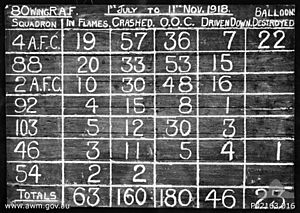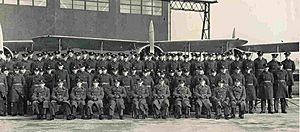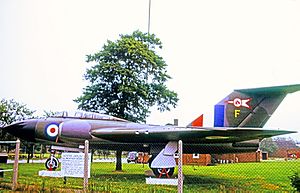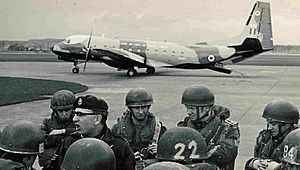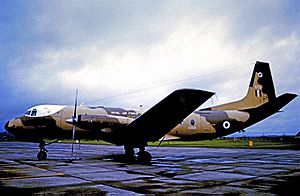No. 46 Squadron RAF facts for kids
No. 46 Squadron was a famous unit of the Royal Flying Corps and later the Royal Air Force. It was first formed in 1916 and then stopped and started again three times before it was finally closed down in 1975. This squadron played a big part in both World War I and World War II.
Quick facts for kids No. 46 Squadron |
|
|---|---|
| Active | 19 April 1916 – 31 December 1919 1936 – 20 February 1950 15 August 1954 – 30 June 1961 1 December 1966 – 31 August 1975 |
| Country | |
| Branch | |
| Motto(s) | "We rise to conquer" |
| Battle honours | Western Front, 1916–18: Messines, 1917*: Cambrai, 1917*: Home Defence, 1917: Somme, 1918*: Hindenburg Line: Norway, 1940*: Battle of Britain, 1940*: Home Defence, 1940–41: Fortress Europe, 1941: Malta, 1941–42*: El Alamein*: Egypt & Libya, 1942–43: Mediterranean 1942–43: South-East Europe, 1944*: Honours marked with an asterisk are those emblazoned on the Squadron Standard |
| Insignia | |
| Squadron badge heraldry | Two arrowheads, surmounted by a third, all in bend. The arrows in the badge signify speed in getting into action and their position and number represent three aircraft climbing. |
| Squadron codes | RJ Apr 1939 – Sep 1939 PO Sep 1939 – Jun 1941 XK Jan 1945 – Feb 1950 |
| Post-1950 squadron roundel |  |
Contents
World War I Service
No. 46 Squadron started at Wyton airfield on April 19, 1916. It moved to France in October that year. At first, it used Nieuport two-seater planes.
Early Missions
The squadron helped with artillery, took photos, and flew reconnaissance missions. This meant they helped direct cannon fire, took pictures of enemy areas, and spied on enemy movements. In May 1917, they got Sopwith Pup planes and started taking on more attacking roles. They were based at La Gorgue airfield for a short time.
This change to a fighter squadron happened when German planes were becoming very strong. Famous German pilot Manfred von Richthofen (the "Red Baron") led special groups of planes that were very effective. No. 46 Squadron fought many battles against the enemy.
Defending London
In July 1917, No. 46 Squadron returned to England to help defend London. German Gotha bombers had recently attacked the city. The squadron patrolled the skies, and no enemy planes got through their area. They went back to France at the end of August.
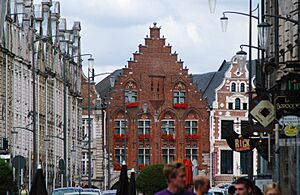
Besides attacking enemy planes, the squadron also attacked targets on the ground with machine guns. They helped soldiers on the ground during the attack on Messines Ridges.
In November 1917, the squadron received Sopwith Camel planes. These planes were very helpful to the infantry (foot soldiers) during the Battle of Cambrai.
End of the War
In the last year of the war, the squadron bombed enemy supply lines and storage areas behind the front lines. After a big German attack in March 1918, 46 Squadron carried out intense low-level ground attacks. This led to many pilots and planes being lost.
In June 1918, the squadron became part of No. 80 Wing RAF. This group focused on large attacks on enemy airfields. In October and November, the squadron was heavily involved in attacks during the German retreat, just before the war ended.
By January 1919, the squadron became a smaller group. It returned to England in February and was officially closed down on December 31.
During World War I, 46 Squadron claimed to have shot down 184 enemy planes. They also had 16 "aces," which are pilots who have shot down five or more enemy aircraft. Some of these famous aces included:
- Donald MacLaren, who shot down 48 planes and 6 balloons. He was one of the top aces of World War I.
- Cecil (Chaps) Marchant
- George Thomson
- Harry Robinson
- Clive Brewster-Joske
- Roy McConnell
- Maurice D. G. Scott
- Maurice Freehill
- Philip Tudhope
- Arthur Gould Lee, who later became a high-ranking officer.
- Victor Yeates, who wrote the book Winged Victory.
Between the World Wars
The squadron was started again at Kenley in 1936. It was part of a plan to make the RAF bigger. They first received Gloster Gauntlet planes and carried out normal training. Future famous pilots like Bunny Currant and Ian Gleed joined the squadron around this time.
World War II Service
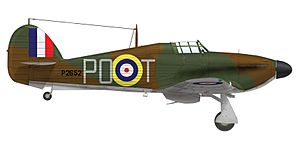
Norway Campaign
When World War II began, 46 Squadron was at RAF Digby with their new Hawker Hurricane planes. They quickly saw action in October 1939. Three pilots attacked 12 German Heinkel 115 planes, destroying one each. For the next six months, they mostly protected ships along the East Coast.
In May 1940, the squadron was chosen to join the British forces in Norway. Germany had invaded Norway on April 9. The Hurricanes were loaded onto the aircraft carrier HMS Glorious. Even though it was risky, all the Hurricanes successfully took off from the ship. No. 46 Squadron started flying missions from Bardufoss on May 26. They patrolled over land and naval forces near Narvik without much rest. Conditions on the ground were very basic.
They fought many air battles in Norway, destroying at least 14 enemy planes. On June 7, the squadron was told to leave Norway immediately. That night, the Hurricanes flew back to Glorious. This was dangerous because the planes didn't have hooks to land on a carrier deck. The ground crews got back to the UK safely, but the squadron's planes and eight pilots were lost when Glorious was sunk by German warships on June 9, 1940. Only two pilots survived: Squadron Commander "Bing" Cross and Flight Commander "Jamie" Jameson.
Battle of Britain
The squadron was re-formed at RAF Digby and was ready for action again by the end of June. For the next two months, they flew patrols to protect convoys. Then they moved south to Stapleford Tawney to help defend London during the Battle of Britain. At this time, the German air force (Luftwaffe) was mainly attacking targets on the coast and ships near Essex and Kent.
The squadron now had many new pilots and no experienced leaders after their losses in Norway. They suffered heavy losses fighting against many more German bombers and fighters. But the Germans also lost so many bombers that they had to change their plans. German planes started flying very high and using cloud cover. This made it hard for 46 Squadron to intercept them, so they also had to change their tactics, flying patrols at very high altitudes.
In early November 1940, No. 46 Squadron found about 50 Italian bombers and fighters over Foulness. They destroyed at least eight of them without any losses to the squadron. The remaining Italian planes scattered.
From July to December 1940, the squadron claimed 34 enemy planes destroyed. However, they lost 26 of their own planes, and 16 pilots were killed, with three badly wounded. After the Battle of Britain, the squadron continued to patrol convoys and escort bombers attacking targets in occupied France.
North Africa
In May 1941, the squadron prepared to go overseas. The ground crews arrived in Egypt in July. Pilots from 46 Squadron also helped defend Malta, later joining 126 Squadron. They were constantly in action, claiming to have destroyed nearly 10 German and 10 Italian planes.
In May 1942, the airmen moved to Idku and became a night fighter squadron with Beaufighters. They were ready for action by the end of the month. Their main jobs were to stop enemy spy planes and bombers, especially over Alexandria, and to protect ships carrying supplies to Malta. In October, after the 8th Army advanced from El Alamein, 46 Squadron attacked retreating enemy forces in the Mersa Matruh area.
In November 1942, the squadron became part of the RAF Coastal Command. They protected convoys near Malta and Benghazi. They also attacked targets in Africa and Sicily, shooting at barges, trawlers, and other small ships with cannons and machine guns. In January, the squadron prepared to go back to being a night fighter unit. By April, they had groups operating in places nearly 1,000 miles apart, which made managing the squadron very hard.
The squadron also did some unusual tasks. Once, they found a group of local troops lost in the desert. Another time, they found a grounded destroyer and protected it until it could move again.
In April 1943, for the first time in the war, a night fighter was controlled from a warship. In July, the squadron had 31 confirmed enemy planes shot down. They then helped guide the invasion fleet sailing for Sicily. By the end of August, a large group was in Cyprus, mainly doing night attacks over Rhodes. On September 14, Squadron leader Cuddie landed on the recently captured island of Kos. This was the first Allied plane to do so. Less than three weeks later, the Germans invaded, and Wing Commander G.A. Reid was killed.
In early 1944, night patrols over Rhodes, Kos, and Crete were the main activities. In February and March, the squadron claimed to have destroyed five Junkers Ju 52 planes and probably three more. In September, their planes were controlled by HMS Ulster Queen, a ship that helped guide planes. They destroyed 11 enemy planes that month.
From September 26 to October 11, a group was based at Gambut. They destroyed 16 enemy planes. Four airmen received medals for their bravery:
- Warrant Officer Roy Butler (pilot), Distinguished Flying Cross (five planes destroyed)
- Warrant Officer Ray Graham (navigator), Distinguished Flying Cross
- Warrant Officer Denis Hammond (pilot), Distinguished Flying Cross (three destroyed or damaged)
- Flight Sergeant Harrison (navigator) Distinguished Flying Medal
A Ju 52 plane destroyed on October 3 was the last German plane shot down by the squadron. As German forces left Greece, the squadron's mission ended.
End of World War II
The airmen arrived at RAF Stoney Cross in January 1945 and began working for Transport Command. Using Short Stirling planes, they flew services to the Far East. After the war ended in August 1945, flights were first limited to India and the Middle East. Then, in early 1946, Dakotas replaced the Stirlings. They carried passengers and goods mainly to Rome, Berlin, Warsaw, and Vienna.
Berlin Airlift
The squadron moved to RAF Manston in October 1946 and to Abingdon in December. From July 1948, the squadron was almost completely involved in the Berlin Airlift. They first flew from Wunsdorf, carrying food. Later, they flew from Fassberg and Lübeck, carrying coal. They returned to RAF Oakington in August 1949 and went back to their normal transport duties until they were closed down on February 20, 1950.
First Post-War Re-formation
Meteor Jets
The squadron was started again at RAF Odiham on August 15, 1954. This time, it was a night fighter unit using Meteor NF12s and NF14s. Training began right away. By the end of October, the squadron had 12 Meteor NF12 or NF14 planes and one Meteor 7 for training.
By June 1955, the squadron had received some Meteor 8s for target towing and had many officers and airmen. In August, when the squadron went to Acklington for gunnery practice, they had 16 aircraft.
Javelin Jets
In January 1956, the unit began switching to Javelin jets. The first ones arrived in February. By May, all pilots had learned to fly the Javelins, and the squadron had 15 of them. They even managed to fly 1,000 hours in two months with eight Javelins, which was thought to be impossible. On June 15, the squadron lost its commanding officer, Wing Commander Birchfield, in a Javelin crash.
Over the years, the squadron continued to train by taking part in many exercises. They also tested new pressure suits and helmets. There were often problems with planes needing repairs and a lack of spare parts, even when the Mk 2 Javelins replaced the Mk 1s in 1957.
In April 1959, the squadron sent six Javelins to visit a French Air Force squadron in Tours, France. In return, the French sent their Sud Aviation Vautour planes to Odiham. In June, the squadron won the Ingpen Trophy for their performance. On June 30, 1961, the squadron was closed down again.
Second Post-War Re-formation
Andover Transport Planes
On September 1, 1966, the squadron was started again at RAF Abingdon as a transport unit. The first Hawker Siddeley Andover CMk1 planes arrived in December. The squadron's job was to transport supplies and troops. The Andover's special ability to "kneel" (lower its back ramp) made it easy to load vehicles. Over the years, the squadron became very good at:
- Medical evacuations (flying injured people)
- Short take-offs and landings
- Flying long routes
- Dropping parachutists and one-ton containers
Besides carrying equipment, vehicles, passengers, or paratroopers, the Andover could also be set up for VIPs. It carried important government officials and was even used for Prince Charles's parachute jump in July 1971.
The squadron also tested new radio systems and long-range fuel tanks. These tanks allowed the Andover to fly long distances, like from Gander to Abingdon in less than eight hours.
The squadron took part in exercises in Libya, Cyprus, the Middle East, Norway, and also in the UK and Germany. They won the Lord VC Trophy in 1968 and 1971. In July 1968, the squadron supported an exercise in Greenland, resupplying and then picking up the team. In March 1969, three planes went to Coolidge, Antigua, to help with the Anguillan crisis. The squadron was the first in the RAF to have a German exchange officer, and they had exchange visits with German air force units.
In August 1969, the unit started helping with duties in Northern Ireland, especially transporting people. On October 13 that same year, King Olav V of Norway presented the squadron with its standard (a special flag). This was to remember the squadron's operations in Norway in 1940.
In September 1970, the squadron moved to RAF Thorney Island. They began more worldwide activities, taking part in a large exercise in the Far East. In 1971, they started a two-plane group at Masirah and added SAR (Search and Rescue) to their jobs. In November 1971 and February 1972, they took part in exercises in Pisa, Italy, and Puerto Rico.
On April 8, 1972, while flying the RAF Falcons (the Royal Air Force Parachute Team), one of 46 Squadron's Andovers crashed on takeoff in Siena, Italy. Four passengers were killed.
Twice a year, the squadron took part in Exercise MACDROP at RAF Machrihanish. Here, Andovers were used to drop parachutists from the Parachute Regiment and the SAS. In January and December 1974, the squadron's planes supported Royal Engineers in Exercise Mirza. This was a four-month program to help build bridges in Sudan.
Finally, in March 1975, it was announced that RAF Thorney Island would close, and the squadron would be disbanded. The number of planes and flying hours were quickly reduced. On August 31, 1975, the squadron's standard was placed in Chichester Cathedral, and the unit was officially closed down.
Some Andovers were changed to do flight calibration duties. Two went to Boscombe Down, and one was used for photo reconnaissance. Later, 10 Andovers were sold to the Royal New Zealand Air Force.
Reunions
No. 46 Squadron is special in the Royal Air Force because it is the only squadron to have held reunions every year since 1917. The squadron's Association has held annual Reunion Dinners continuously since 1917. The 100th reunion was held on June 3, 2017.
Aircraft Used
| Model | When it was used |
|---|---|
| Nieuport 12 | April 1916 – April 1917 |
| BE2c | November 1916 – April 1917 |
| BE2e | February 1917 – April 1917 |
| Pup | April 1917 – November 1917 |
| Camel | November 1917 – February 1919 |
| Gauntlet II | September 1936 – February 1939 |
| Hurricane I | February 1939 – December 1940 |
| Hurricane IIA | December 1940 – May 1941 |
| Hurricane IIC | May 1941 – June 1941 |
| Beaufighter I | May 1942 – July 1942 |
| Beaufighter VI | May 1942 – December 1944 |
| Beaufighter X | April 1944 – July 1944 |
| Mosquito XII | April 1944 – July 1944 |
| Stirling V | February 1945 – February 1946 |
| Dakota III, IV | February 1946 – February 1950 |
| Meteor NF 12 | August 1954 – March 1956 |
| Meteor NF 14 | August 1954 – March 1956 |
| Javelin FAW 1 | March 1956 – November 1957 |
| Javelin FAW 2 | August 1957 – June 1961 |
| Javelin FAW 6 | June 1958 – October 1958 |
| Andover CMk1 | December 1966 – August 1975 |
Locations
| Location | Dates |
|---|---|
| RAF Wyton | April 1916 – October 1916 |
| Boisdinghem | May 1917 – May 1917 |
| La Gorgue | May 1917 – July 1917 |
| Bruay | July 1917 – July 1917 |
| Sutton's Farm | July 1917 – August 1917 |
| Ste Marie Cappel | August 1917 – September 1917 |
| (Izel) Le Hameau | September 1917 – May 1918 |
| Liettres | May 1918 – June 1918 |
| Serny | June 1918 – August 1918 |
| Poulainville | August 1918 – September 1918 |
| Cappy | September 1918 – October 1918 |
| Athies | October 1918 – October 1918 |
| Busigny | October 1918 – November 1918 |
| Baizieux | November 1918 – February 1919 |
| Rendcomb | February 1919 – February 1919 (disbanded) |
| Re-formed out of 'B' Flt, No. 17 Sqn, Kenley | September 3, 1936 |
| RAF Kenley | September 1936 – November 1937 |
| RAF Digby | November 1937 – November 1939 |
| RAF Acklington | November 1939 – January 1940 |
| RAF Digby | January 1940 – May 1940 |
| HMS Glorious | May 1940 – May 1940 |
| Skaanland | May 1940 – May 1940 |
| Bardufoss | May 1940 – June 1940 |
| HMS Glorious | June 1940 – June 1940 |
| RAF Digby | June 1940 – September 1940 |
| Stapleford Aerodrome | September 1940 – November 1940 |
| RAF North Weald | November 1940 – December 1940 |
| RAF Digby | December 1940 – February 1941 |
| RAF Church Fenton | February 1941 – March 1941 |
| RAF Sherburn-in-Elmet | March 1941 – May 1941 |
| En route Egypt | May 1941 – July 1941 |
| Abu Sueir | July 1941 – September 1941 |
| Kilo 17 | September 17, 1941 – May 1942 |
| Idku | May 1942 – December 1944 |
| RAF Stoney Cross | January 1945 – October 1946 |
| RAF Manston | October 1946 – December 1946 |
| RAF Abingdon | December 1946 – August 1949 |
| RAF Oakington | August 1949 – February 1950 (disbanded) |
| RAF Odiham | August 1954 – July 1959 |
| RAF Waterbeach | July 1959 – June 1961 (disbanded) |
| RAF Abingdon | September 1966 – September 1970 |
| RAF Thorney Island | September 1970 – August 1975 (disbanded) |
Commanding Officers
| Rank | Name | Date of Command |
|---|---|---|
| Major | G. E. Todd | April 1916 |
| Major | E. L. Conran | May 1916 |
| Major | L. Dawes | May 1916 |
| Major | P. Babington | July 1916 |
| Major | R. H. S. Mealing | December 1917 |
| Major | A. H. O'Hara-Wood | July 1918 |
| Major | G. Allen | October 1918 |
| Squadron Leader | M. F. Calder | September 1936 |
| Squadron Leader | P. R. Barwell | June 1937 |
| Squadron Leader | K. B. B. Cross | October 1939 |
| Squadron Leader | J. R. Maclachlan | June 1940 |
| Squadron Leader | A. R. Collins | October 1940 |
| Squadron Leader | L. M. Gaunce | October 1940 |
| Squadron Leader | A. C. Rabagliati | December 1940 |
| Wing Commander | G. A. Reid | May 1942 |
| Wing Commander | T. P. K. Scade | October 1943 |
| Wing Commander | R. W. Dennison | June 1944 |
| Squadron Leader | G. E. Robertson | August–November 1944 (Temporary Command) |
| Wing Commander | B. A. Coventry | January 1945 |
| Wing Commander | S. G. Baggott | December 1945 |
| Wing Commander | G. Dutton | March 1946 |
| Wing Commander | G. Burges | July 1946 |
| Squadron Leader | E. Moody | October 1947 |
| Squadron Leader | A. G. Salter | April 1948 |
| Squadron Leader | A. Reece | August 1949 |
| Squadron Leader | D. F. C. Ross | August 1954 (on re-forming) |
| Wing Commander | F. E. W. Birchfield | March 1955 |
| Wing Commander | H. E. White DFC ** AFC | June 1956 |
| Wing Commander | F. B. Sowrey | May 1958 |
| Wing Commander | D. B. Wills | June 1960 |
| Squadron Leader | M. T. Rayson | September 1966 (on re-forming) |
| Squadron Leader | J. B. Gratton | December 1967 |
| Squadron Leader | D. O. Crwys-Williams | January 1970 |
| Wing Commander | F. A. Mallett | February 1971 |
| Wing Commander | J. A. Scambler | April 1973 |
| Wing Commander | S Hitchen | March 1975 |


